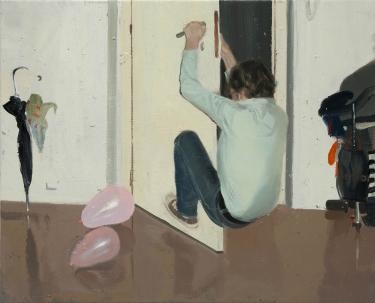Pere Llobera
01 May - 12 Jun 2010
PERE LLOBERA
"Tired of being strong"
01 May 2010 - 12 Jun 2010
I have been watching some beggars drawing. There is one in my street who greets my children with an almost animal-like mumble. He never speaks; this skill seems to have deserted him. What most resembles traces of human communication are these sounds with which he accompanies his gesture of waving when my children walk past, and the spit in the air he dedicates to me from time to time. It seems that he knows something about me and this is how he chooses to let me know.
This beggar drags his leg and doodles obsessively on a small piece of paper, drawing lines, borders, mere abstractions. Klee would like them but they worry me. It worries me, professionally speaking, that artists may be simply that: people who fill emptiness with their deliriums.
Meaninglessness: when do you pass it? Can you ignore it? When does your work as an artist possess significance, and when is it mere form, stuffing, personal doodling? That is the question that preoccupies Pere Llobera (Barcelona, 1970). Tired of being strong refers to a feeling of futility; it is about a loss of faith in the significance of politics, of money, power, and of the search for truth.
In one of Pere Llobera’s new works (Untitled, 2010), we see him hanging from a door-handle, lifting both legs, hovering above the ground like a child at play. The brushstrokes are smooth, an alternating mix of impasto and smoothness, and look spontaneous and simple. His work externalises the human as a creative being, homo ludens, balloons on the ground as vanitas symbols, cheerful, childish, but finite. As an artist, as a painter, he searches deep within his inner being for the nucleus of his creativity. What he seeks is the place where his work adds something; where a painting can matter, where it transcends the personal and the finite.
[Laura van Grinsven]
"Tired of being strong"
01 May 2010 - 12 Jun 2010
I have been watching some beggars drawing. There is one in my street who greets my children with an almost animal-like mumble. He never speaks; this skill seems to have deserted him. What most resembles traces of human communication are these sounds with which he accompanies his gesture of waving when my children walk past, and the spit in the air he dedicates to me from time to time. It seems that he knows something about me and this is how he chooses to let me know.
This beggar drags his leg and doodles obsessively on a small piece of paper, drawing lines, borders, mere abstractions. Klee would like them but they worry me. It worries me, professionally speaking, that artists may be simply that: people who fill emptiness with their deliriums.
Meaninglessness: when do you pass it? Can you ignore it? When does your work as an artist possess significance, and when is it mere form, stuffing, personal doodling? That is the question that preoccupies Pere Llobera (Barcelona, 1970). Tired of being strong refers to a feeling of futility; it is about a loss of faith in the significance of politics, of money, power, and of the search for truth.
In one of Pere Llobera’s new works (Untitled, 2010), we see him hanging from a door-handle, lifting both legs, hovering above the ground like a child at play. The brushstrokes are smooth, an alternating mix of impasto and smoothness, and look spontaneous and simple. His work externalises the human as a creative being, homo ludens, balloons on the ground as vanitas symbols, cheerful, childish, but finite. As an artist, as a painter, he searches deep within his inner being for the nucleus of his creativity. What he seeks is the place where his work adds something; where a painting can matter, where it transcends the personal and the finite.
[Laura van Grinsven]

